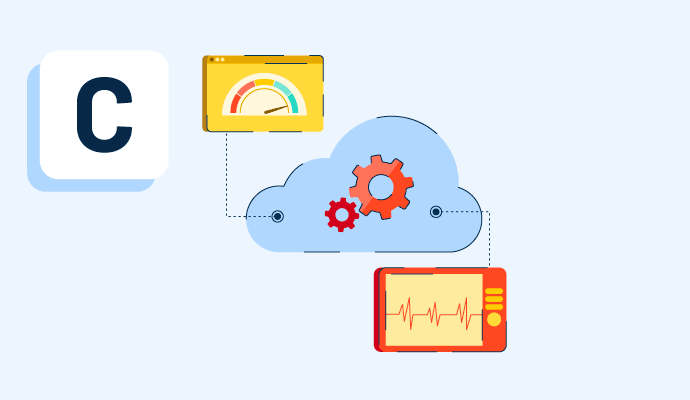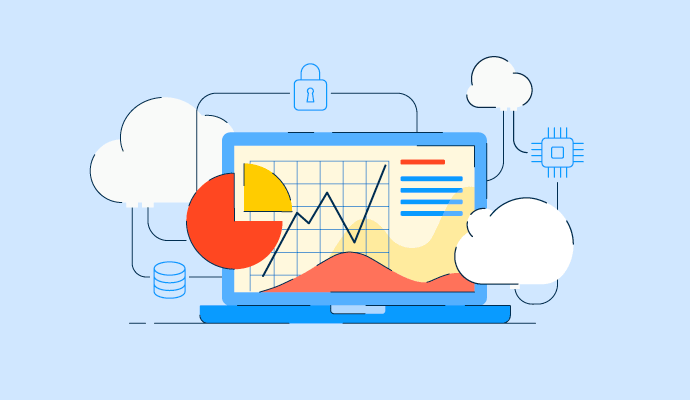What is cloud monitoring?
Cloud monitoring is the process of analyzing, tracking, and managing cloud-based infrastructure and applications to ensure optimal performance, availability, and security. It helps businesses fix problems in the cloud environment before they affect the end-user experience.
Cloud monitoring is part of cloud management and security processes. It includes manual or automated techniques and tools to track and analyze application performance, network availability, resource allocation and utilization, and security events. This continuous evaluation helps prevent potential problems like downtime, data loss, and compliance issues.
Cloud monitoring has become a priority for IT and DevOps teams as businesses increasingly adopt multiple cloud services. It provides them with much-needed insight into the cloud environment.
Tools like cloud infrastructure monitoring software and cloud security monitoring software assist with automated cloud monitoring.
Types of cloud monitoring
Businesses use different types of cloud computing services like software as a service (SaaS), platform as a service (PaaS), and infrastructure as a service (IaaS). They also employ public, private, hybrid, or multi-cloud architectures.
As a result, it becomes crucial to stay on top of different parts of the cloud and ensure everything works together seamlessly. For this purpose, there are different types of cloud monitoring techniques.
- Database monitoring actively monitors database resources that cloud applications rely on. It tracks the availability of services, query response times, and number of transactions per second, monitors database health, and ensures data integrity.
- Website monitoring involves monitoring the availability, performance, and user experience of cloud-hosted websites. Website monitoring tools track website uptime, page load times, rate of network requests, and server response times, and detect errors or downtime.
- Application performance monitoring (APM) is a critical component of cloud monitoring. It measures the availability and performance metrics of distributed cloud-based apps in a single pane of glass. APM software helps IT teams quickly troubleshoot issues, and boost functionality and observability of the enterprise application environment. It improves user experience, minimizes application downtime, and meets service level agreements (SLAs).
- Cloud storage monitoring focuses on evaluating the usage, performance, and availability of cloud storage resources used by virtual machines, services, databases, and applications.
- Virtual machine (VM) monitoring tracks the users, traffic, workloads, and capacity of virtual machines scaled out in IaaS solutions. It helps spot underutilized or overused VMs and streamline resource allocation.
- Virtual network monitoring is used to check network connectivity and health. It ensures their virtual network components like routers and load balancers aren’t overwhelmed with unwanted traffic, and their vital cloud network connections aren’t offline.
- Unified monitoring is more of a strategy than a technique focused on entire IT monitoring, including cloud services. It brings together monitoring of network, server, storage, databases, virtual machines, containers and all cloud services under a single umbrella instead of a separate point solution. Organizations can configure a unified cloud monitoring solution from single or multiple vendors to get full visibility into their tech stack end-to-end.
Based on a company's cloud environment and needs, these monitoring techniques can be used together or separately.
Importance of hybrid and multicloud monitoring
Today, many organizations adopt hybrid cloud and multi-cloud architectures to benefit from different cloud providers and maintain flexibility in their infrastructure.
While a private cloud offers extensive visibility and control, the same can’t be said about a public cloud. Similarly, hybrid or multicloud models don’t offer great insight into the cloud environment because they combine multiple cloud deployment models on top of on-premise infrastructure. They add complexity and make it difficult to identify bottlenecks in the cloud environment, inhibiting performance and usage.
Cloud monitoring solutions solve these issues. They provide smooth integrations with cloud vendor performance data, aggregate those from various cloud services and provide total visibility under a single platform. This allows IT and DevOps teams to make better cloud management decisions.
Benefits of cloud monitoring
Cloud monitoring gives enterprises a holistic picture of the complex, distributed cloud environment using interactive dashboards. It helps troubleshoot issues before they cause disruption. This increases IT teams' efficiency and plays a crucial role in how cloud applications function. And these are just some of the advantages.
- Enhanced security: By monitoring cloud resources, services, and access patterns, organizations detect and mitigate cybersecurity threats promptly. It helps ensure data protection, compliance with industry regulations, and early identification of unauthorized access attempts or suspicious activities.
- Effective capacity planning: Cloud monitoring services provide cloud usage patterns and performance trends that help enterprises effectively plan their cloud capacity. They can scale resources up or down based on demand and optimize resource allocation.
- Cloud cost optimization: Capacity planning also helps reduce unnecessary cloud spend by identifying inefficiencies with overprovisioning and underprovisioning of cloud resources.
- Proactive issue resolution: Automated cloud monitoring notifies cloud administrators about performance issues in real time so the IT team addresses the problems before they impact users or disrupt operations, reducing the mean time to repair (MTTR) and improving overall system reliability.
- Improved end-user experience: By monitoring application performance and responsiveness, organizations enhance the user experience and ensure the best service delivery and customer satisfaction.
Cloud monitoring best practices
As important as it is, businesses need to follow several practices to get the most out of their cloud environment.
- Define objectives. Goal-setting is foremost for any IT monitoring strategy. Organizations should lay out specific goals and establish key metrics and key performance indicators (KPIs) for cloud monitoring specific to their cloud infrastructure.
- Use a unified platform. Businesses should use a single platform to view and manage all data in one place and have complete visibility into their cloud environment in real time.
- Utilize automation. Automation in cloud monitoring tools improves data collection, analysis, notifications, and visualization. It reduces manual effort, ensures consistency, and enables proactive monitoring across large-scale cloud environments. Businesses should turn to automation to significantly increase the operational efficiency of IT teams.
- Use performance baselines. Analyze historical data from cloud applications and the connected infrastructure and establish performance benchmarks to compare current performance against expected norms. This aids in identifying anomalies and performance degradation.
- Review and refine. Businesses should regularly assess the effectiveness of their IT monitoring setup and make necessary adjustments. For the best outcomes, they should continuously refine their strategy based on evolving business requirements, changes in application architecture, and emerging industry practices.

Soundarya Jayaraman
Soundarya Jayaraman is a Content Marketing Specialist at G2, focusing on cybersecurity. Formerly a reporter, Soundarya now covers the evolving cybersecurity landscape, how it affects businesses and individuals, and how technology can help. You can find her extensive writings on cloud security and zero-day attacks. When not writing, you can find her painting or reading.


















